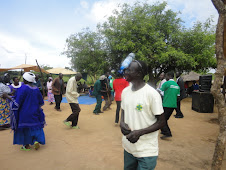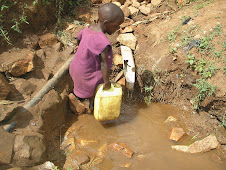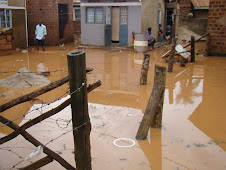I used to spend 3hr a day collecting 3 jerry cans of water
from 3 km away my home (as narrated by Adio Baveto 34 year old). This water was
not enough for my home including my animals. My animals used to get scattered
to look for water anywhere they would get it. In the process, they would
destroy people’s gardens. This would result into serious misunderstandings and quarreling
with fellow village members almost on a daily basis. Sometimes, we would use
water from Pagada River as it was nearer and no waiting time wasted as it was
the case in the neighboring village. However this was not safe and on many
occasions, my children complained of stomach pain and diarrhea.
Amref Health Africa came as our savior. Having assessed our
WASH situation, they first sensitized us about what we were required to do
before getting a water point. This necessitated all HHs having toilets, and the
capital contribution of UGX 200,000/=. We raised the money and those who never
had latrines started digging pits and putting structures.
Water source used before the project
Scooping water from small halls (we
thought it was safer)
Majority of the village members positively supported
construction works by giving food to contractors, supervision, collecting poles
and fencing off the borehole.
The Water User Committee (WUC) was established and trained.
This helped much in formulating guiding bye laws, and collecting water user
fees (UGX 1000 per HH). Well-wishers clean the bore hole on a daily basis as we
want to maintain it clean all times. I am able to collect more than 6 jerry
cans a day without wasting much time. This water is enough for our domestic use
including animals. It even saved me from the misunderstandings that would
develop due to my animals encroaching on neighbours gardens as they looked for
water.
Adio is a famer and a brick maker. “I have benefited more
from this water source. My family member collects enough water for use at home
and I collect more water for making my bricks here. So far I have made 10,000
bricks and am still making more. Each brick will go for UGX 200 and once I sell
my bricks, I will contribute more UGX 10,000 (equivalent to USD 4) to the
maintenance fund for this borehole. We will ensure its good operation and
maintenance and we consider this water point 100% for the people of Oyera
village not for Amref because it is benefiting us (said by Patric).
Neighboring village members all collect water from the same
source. Our plan is to list these HHs and collect water user fees from them.
This will help us during any breakage/repair.
We sincerely thank Amref Health Africa for constructing this
water point to the people of Oyera Village and surrounding community members.












































No comments:
Post a Comment